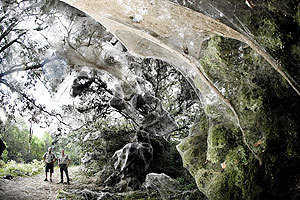If you hate creepy-crawlies, you might want to avoid Lake Tawakoni State Park where a 200-yard stretch along a nature trail has been blanketed by a sprawling spider web that has engulfed seven large trees, dozens of bushes and even the weedy ground.
But if you hate mosquitoes, you might just love this bizarre web.

|
| ©STAR-TELEGRAM / Tom Pennington
|
| Lake Tawakoni State Park rangers Mike McCord, left, and Freddie Gowin monitor the growth of a giant communal spider web at the park Tuesday. The web, rare for Texas, has formed over the past several weeks.
|
"At first, it was so white it looked like fairyland," said park superintendent Donna Garde. "Now it's filled with so many mosquitoes that it's turned a little brown. There are times you can literally hear the screech of millions of mosquitoes caught in those webs."
There have been heated Internet discussions among experts that the webs were constructed by social cobweb spiders, which work together, or perhaps a mass dispersal where the arachnids spin webs to spread out from one other. Either way, it's generating a lot of bug buzz.
"I've been hearing from entomologists from Ohio, Kansas, British Columbia -- all over the place," said Mike Quinn, a Texas Parks and Wildlife invertebrate biologist who first posted photos of the web on the Web. But there is little consensus about what sparked the phenomenon or even the type of spider responsible. Parks officials say similar but smaller webs have sprouted along another trail.
"From what I'm hearing it could be a once-in-a-lifetime event," said Herbert A. "Joe" Pase, a Texas Forest Service entomologist. "It's very, very unusual."
Park officials say they have encountered mixed reactions to the web from visitors.
"Some can't wait to see it while others don't want go anywhere near it," said Trisha Brian, a park volunteer. "It's definitely not for everyone but I'm so fascinated by it that I come down to look at it every day. Every time I come by, there's something new."
But one Texas spider expert was having trouble mustering excitement about the giant web.
John Jackman, a professor and extension entomologist for Texas A&M University and author of A Field Guide to the Spiders and Scorpions of Texas, said he receives similar reports every couple of years.
"There are a lot of folks that don't realize spiders do that," Jackman said. "Until we get some samples sent to us we really won't know what species of spider we're talking about."
Garde, the park superintendent, just wishes the entomologists would check out the spider web in person instead of arguing about it over the Internet.
"I invite them all to please come out take a look," he said. "If you want to know what it is, why don't you come out and see it firsthand? Somebody needs to come out that's an expert. I would love to see some entomology intern come out and study this."
Park officials say similar but smaller cobwebs have sprouted up along another trail. Rangers say they expect that the giant web will stick around until fall when the spiders start dying off. Unfortunately, it probably won't last until Oct. 31.
"It would make a good Halloween set, wouldn't it?" said park ranger Freddie Gowin, who discovered the giant cobweb while mowing about a month ago. "But I don't think you could pay me enough money to run through all of those webs."

Reader Comments